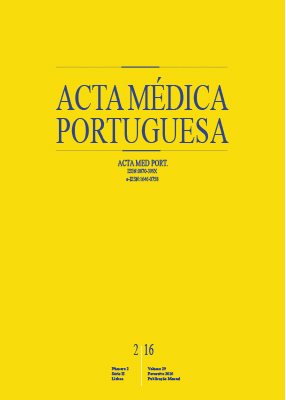Parcial Nephrectomies - results of 12 years from an Oncology Institution
DOI:
https://doi.org/10.20344/amp.5231Keywords:
Chronic Disease, Glomerular Filtration Rate, Nephrectomy, Renal Insufficiency.Abstract
Introduction: The diagnosis of renal cell carcinoma has been increasing in recent years, especially due to incidental cases, and thus indication for nephron-preserving surgery has also risen.
Objectives: To review a series of partial nephrectomies from an oncology institution namely technique features, survival and change in renal function.
Material and Methods: A retrospective analysis of all patients with renal tumors that were submitted to partial nephrectomy at our institution between January 2000 and December 2012.
Results: A total 156 partial nephrectomies were performed, 85 in men and 71 in women, with mean overall age of 62 ± 15 years. Surgical approach was transperitoneal laparoscopic in 23 cases with the remainder 133 through lumbotomy. Mean ischemic time was < 25 min in all patients and complication rate was 10.9 %, mostly corresponding grade 2 and 3 of the Clavien-Dindo scale. Mean tumor size was 2.9 ± 1.4 cm and the surgical margin was focally affected by tumor in 9.6% of cases. Histologically, 26.2% of cases corresponded to clear cell renal cell carcinoma, with oncocytomas being the most common benign neoplasm with 14.7% of the total. There were 4 cases of recurrence and one case death at follow-up. The mean change in estimated glomerular filtration rate was -5.3 mL/min per 1.73 m2 (p < 0.001). There was no association between warm ischemia time, body mass index, age, ASA score, presence of complications with this decrease in glomerular filtration rate.
Discussion: Our positive surgical margins cases were slightly above what is described in literature, however we didn’t find any predictive factor for such finding and ultimately there was no evidence of tumor recurrence or influence in survival in all these cases. Even though there was a significant decrease in estimated glomerular filtration rate, warm ischemia time was very low and only five patients presented with de novo eGFR < 60 mL/min per 1.73 m2, and two patients started hemodialysis. A high volume center seems to be critical for technique optimization and complication management.
Conclusion: Our series of partial nephrectomies presents oncological results and preservation of renal function similar to those published in literature. This is a safe technique with good results, justifying its growth.
Downloads
Downloads
Published
How to Cite
Issue
Section
License
All the articles published in the AMP are open access and comply with the requirements of funding agencies or academic institutions. The AMP is governed by the terms of the Creative Commons ‘Attribution – Non-Commercial Use - (CC-BY-NC)’ license, regarding the use by third parties.
It is the author’s responsibility to obtain approval for the reproduction of figures, tables, etc. from other publications.
Upon acceptance of an article for publication, the authors will be asked to complete the ICMJE “Copyright Liability and Copyright Sharing Statement “(http://www.actamedicaportuguesa.com/info/AMP-NormasPublicacao.pdf) and the “Declaration of Potential Conflicts of Interest” (http:// www.icmje.org/conflicts-of-interest). An e-mail will be sent to the corresponding author to acknowledge receipt of the manuscript.
After publication, the authors are authorised to make their articles available in repositories of their institutions of origin, as long as they always mention where they were published and according to the Creative Commons license.









